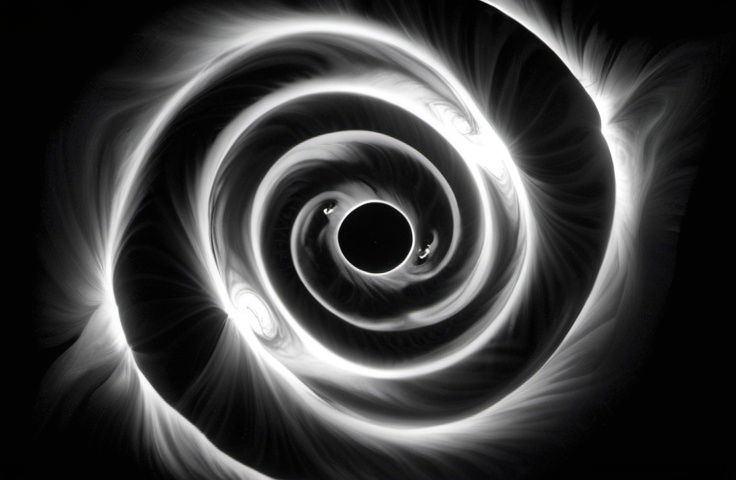New research funded by NASA and the National Science Foundation exploring the role of polar vortices may have finally solved an intriguing mystery occurring at the sun’s poles.
According to the authors of a new study outlining the potentially groundbreaking research, scientists have often assumed that the sun likely forms polar vortices above its north and south poles, much like those observed in the atmospheres of Earth and other planets. However, if they exist, these vortices are influenced by the magnetism in the sun’s plasma, making their formation and effects on solar storms a mystery.
Due to the Coriolis force, vortices develop in fluids surrounding a spinning body. For example, vortices have been spotted above the poles of Earth, Mars, Venus, Uranus, Neptune, and even Saturn’s moon Titan, which has a dense atmosphere.
Now, researchers from the U.S. National Science Foundation National Center for Atmospheric Research (NSF NCAR) have simulated the formation of polar vortices above the sun’s poles. If their findings are correct, they could help solve the mystery at the sun’s poles while offering insights into the Sun’s magnetism and the solar cycle and improving our ability to predict space weather.
“No one can say for certain what is happening at the solar poles,” said NSF NCAR senior scientist Mausumi Dikpati, who led the study. “But this new research gives us an intriguing look at what we might expect to find when we are able, for the first time, to observe the solar poles.”
Solving a Mystery at the Sun’s Poles
Since the launch of the first space missions, several human-made satellites and spacecraft have explored the solar system. These missions have gathered invaluable evidence about the planets and moons that make up our solar neighborhood.
Still, humans have never sent a spacecraft to the necessary location to view the sun’s north and south poles directly, leaving a gap in understanding regarding the possible existence and role of solar polar vortices. This knowledge gap is particularly pronounced since, unlike the atmospheres of planets and moons with polar vortices, the plasma “fluid” that makes up the sun is magnetic. However, the influence of solar magnetism on the formation and evolution of polar vortices remains a mystery, as no space mission has yet been capable of observing the Sun’s poles directly.
“Our conceptual boundary now is that we are operating with only one viewpoint,” said Scott McIntosh, vice president of space operations for Lynker and a co-author of the paper.
Without a mission to directly view the sun’s poles, the NSF NCAR team used simulation software designed to approximate the sun’s complex dynamics. As hoped, those simulations revealed a complex interaction starting at 55 degrees latitude, the equivalent of the Arctic Circle on Earth.
First, the solar plasma began to form polar vortices at the same time as a phenomenon known as “the rush to the poles” commenced. As the name implies, the rush to the poles is a dynamic in which a magnetic field of opposite polarity to the field at the sun’s poles moves quickly toward the polar regions until it replaces the original magnetic field. Previous studies have connected this rush to the poles with the natural solar cycle that constantly occurs on the sun.
Next, the vortices in the simulations began to follow the magnetic field as it “rushed” toward the sun’s north and south poles. According to the study authors, the group of vortices moved in a tightening ring, “shedding vortices as the ring closes” until only a pair of vortices remained at the poles. Finally, these vortices disappeared altogether at the solar maximum.
Future Missions Could Solve the Mystery Once and For All
The researchers say their simulations offer compelling evidence that they have solved the mystery at the sun’s poles. However, they also note that direct observations will be needed to confirm their simulations. “To make significant progress, we must have the observations we need to test our hypotheses and confirm whether simulations like these are correct,” McIntosh said.
NASA and the European Space Agency plan to launch a future mission called the Solar Orbiter, which may catch a glimpse of the sun’s poles. However, according to the study authors, its “first look” will be close to the solar maximum when their simulations show the vortices disappearing.
“You could launch a solar mission, and it could arrive to observe the poles at completely the wrong time,” McIntosh explained.
The study, “A Magnetohydrodynamic Mechanism for the Formation of Solar Polar Vortices,” was published in the Proceedings of the National Academy of Sciences.
Christopher Plain is a Science Fiction and Fantasy novelist and Head Science Writer at The Debrief. Follow and connect with him on X, learn about his books at plainfiction.com, or email him directly at christopher@thedebrief.org.

